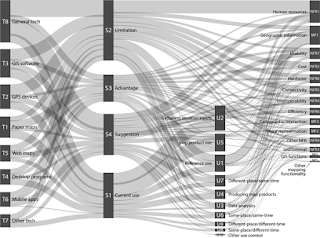This week
Caroline Rose
successfully completed and defended her MS Thesis at the University of Wisconsin, Madison. I had the pleasure of attending virtually and was extremely happy to see her hard work and innovation culminate in a superb presentation. This blog is just an update to let you know the thesis is available for download and highlight some key findings for the SAR Community.
Where can I find the thesis?
Here is the link to the research website where you can read Caroline's work and download a copy: http://cmrrose.github.io/thesis/
What are the highlights?
Caroline conducted interviews with a representative sample of the SAR community and quantified their responses to address three key research questions.
These are the three primary research questions addressed by Caroline's thesis. |
- People are still using a wide variety of software for general mapping, GIS, GPS, and web mapping.
- There are many challenges to using these technologies but almost as many insightful suggestions on how they could be better utilized in the future.
- Of all the challenges discussed, availability or accessibility of human resources, availability and accessibility of geographic information, and software usability appear to be of most concern.
Sankey diagrams are a specific type of flow diagram, in which the width of the connection is shown proportionally to the flow quantity. Here it is applied to the 24 interviews conducted with SAR personnel. It is a way to help you visualize the quantitative data (word utilization) and begin to understand the significance and relatedness of each topic. |
One participant stated that “searches are still solved by people out on foot, thrashing around in terrain. GIS is just a tool... it’s not some magic something where technology saves the day.” What GIS technology offers is another tool in the searcher’s toolbox—a tool with unique advantages that no other form of mapping technology can replace. If GIS can help focus resources, spark a key insight, or streamline incident management, it may make an important difference in an emergency situation. As one participant put it, “any tool that is going to be there for the betterment of the search and the potential of saving that life, why wouldn't you use it?” GIS capability also can be a benefit to WiSAR teams outside of the emergent search event, supporting documentation, prevention, and preparation.
That sounds like a call to action to me!The challenges to GIS use in WiSAR are surmountable, and many efforts are
already underway to improve the usability of, provide training in, contribute expertise from, and promote awareness of GIS. There also have been efforts to expand interoperability across mapping technology, working toward what I suggest is the ideal: not one prescribed system, but a range of compatible tools that leverage the benefits of several different forms of mapping technology, scale to meet the demands of an incident, and facilitate data aggregation across WiSAR incidents.
What does the research mean for the SARGIS Community?
There is a lot of great information extracted from Caroline's interviews that complements the earlier work of Loren Pfau and others. This type of research is really important for informing the SARGIS community on where we should invest our resources.
- We need more people trained in GIS and other mapping technology
- We need more access to up-to-date geographic information
- We need more tools that make mapping technology 'usable'
This thesis, how to take action on the findings, and much more will be discussed at #SARGIS7 in November, details coming soon...
أكثر...

